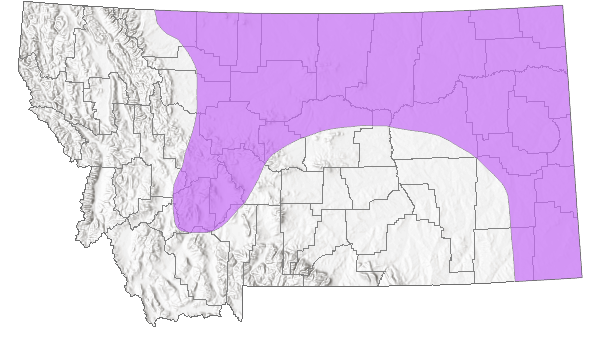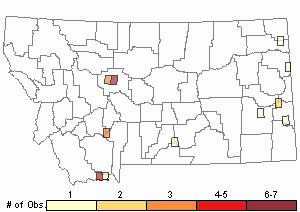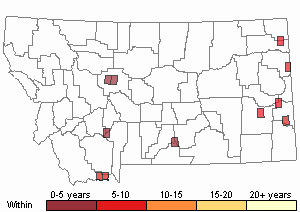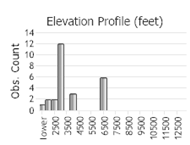View in other NatureServe Network Field Guides
NatureServe
Montana
Utah
Wyoming
Idaho
Wisconsin
British Columbia
South Carolina
Yukon
California
New York
Big Sand Tiger Beetle - Cicindela formosa formosa
General Description
The following is taken from Pearson et al. (2015). This species length is 14-21 mm and it is the largest tiger beetle in Montana. It is bright coppery red above (rarely bright metallic green in northeastern Wyoming) with very broad maculations connected to each other, sometimes to the extent that the first and rear maculations are obscure. It is purple metallic below. There is a broad zone of intergradation with
C. formosa generosa, which is dark brown above, metallic green below with coppery reflections (see
generosa subspecies account).
C. formosa fletcheri, described from specimens collected along the Marias River (Criddle 1925), falls within the range of variation for
C. f. formosa and is considered a junior synonym (Wallis 1961, but see French et al. 2021).
Phenology
Tiger beetle life cycles fit two general categories based on adult activity periods. “Spring-fall” beetles emerge as adults in late summer and fall, then overwinter in burrows before emerging again in spring when mature and ready to mate and lay eggs. The life cycle may take 1-4 years. “Summer” beetles emerge as adults in early summer, then mate and lay eggs before dying. The life cycle may take 1-2 years, possibly longer depending on latitude and elevation (Kippenhan 1994, Knisley and Schultz 1997, Leonard and Bell 1999). Adult Cicindela formosa formosa in the southern part of its range are active from March to July and again August to October; at higher latitudes some adults may be present throughout summer (Larochelle and Larivière 2001, Pearson et al. 2015). In Montana, some adults are active from mid-April to at least mid-September (Criddle 1925, Nate Kohler personal communication).
Diagnostic Characteristics
The following comes largely from Pearson et al. (2015).
C. f. formosa differs from
C. formosa generosa in coloration (bright coppery red above instead of dark brown, metallic purple below instead of metallic green with coppery reflections), and from
C. f. gibsoni in coloration (bright coppery red above instead of dark red to purple above, metallic purple below instead of metallic bluish-violet), and maculations (broad but more distinct instead of maculations sometimes expanded to cover much of the elytra except for a dark wedge down the midline). Differs from the similarly colored and sometimes sympatric
Blowout Tiger Beetle (
C. lengi) by its bulkier larger size, shorter and wider labrum and the front (shoulder) maculation is relatively shorter. The maculations are generally thicker overall.
Species Range
Montana Range
Range Descriptions

 Native
Native
Range Comments
Found across much of the Great Plains region east of the Rocky Mountains, from southern Alberta, Saskatchewan and southwestern Manitoba to eastern New Mexico, northern Texas, western Oklahoma, and northwestern Missouri (Pearson et al. 2015). In Montana, range identical to C. formosa range (Pearson et al. 2015, Nake Kohler personal communication) except absent from Beaverhead County in the southwest.
Observations in Montana Natural Heritage Program Database
Number of Observations: 26
(Click on the following maps and charts to see full sized version)
Map Help and Descriptions
Relative Density

Recency



 (Observations spanning multiple months or years are excluded from time charts)
(Observations spanning multiple months or years are excluded from time charts)
Migration
This species is non-migratory but capable of dispersal. When wings are fully developed (macropterous), it is a strong, agile flier and fast runner (Larochelle and Larivière 2001).
Habitat
Adult and larval tiger beetle habitat is essentially identical. The larvae live in soil burrows (Knisley and Schultz 1997). Across the range Cicindela formosa formosa prefers dry upland sandy areas with little vegetation and no standing water (sand dunes, sand hills), often in short grass and forbs near dune margins, ditches, road cuts, sandy fields, sand flats, and sandy beaches along water courses (Wallis 1961, Acorn 2001, Larochelle and Larivière 2001, Pearson et al. 2015). In Montana, found in stabilized sandy dunes, sandy road cuts and paths, and sandy beaches along water courses (Nate Kohler personal communication).
Food Habits
Larval and adult tiger beetles are predaceous. In general, both feed considerably on ants (Wallis 1961, Knisley and Schultz 1997). Larval Cicindela formosa formosa feed on ants, adults on ants, grasshoppers, carabid beetles (Larochelle and Larivière 2001), and probably other small insects and spiders.
Ecology
Larval tiger beetles live in burrows and molt through three instars to pupation, which also occurs in the larval burrow. Adults make shallow burrows in soil for overnight protection, deeper burrows for overwintering. Adults are sensitive to heat and light and are most active during sunny conditions. Excessive heat during midday on sunny days drives adults to seek shelter among vegetation or in burrows (Wallis 1961, Knisley and Schultz 1997).
Cicindela formosa formosa has a narrow range of ecological tolerance (stenotopic). Larval burrows are up to 33 cm deep in sand with a pit near the entrance used for trapping insects, burrows closed in summer. Adults are diurnal, and gregarious (often occurring in large numbers). They are often found sunning on warm soil, become active at 15-20°C, and burrow in sand to escape excessive heat. Predators include asilid (robber) flies. Escapes by flying quickly, typically short distances (< 10 m), making an audible buzz while in flight, seeking cover in vegetation once landing. Wary and difficult to approach. Other associated tiger beetle species include
Blowout Tiger Beetle (
C. lengi) and
Festive Tiger Beetle (
C. scutellaris) (Larochelle and Larivière 2001). Sometimes occurs in patchy colonies associated with sandy habitats (Pearson et al. 2015). Larvae and newly emerged adults overwinter in burrows (Acorn 2001), larvae up to 3 m deep and adults to 1m (Criddle 1925, Larochelle and Larivière 2001).
Reproductive Characteristics
The life cycle of Cicindela formosa formosa is 2-3 years, depending on elevation and latitude (Larochelle and Larivière 2001, Pearson et al. 2015). Mating reported April to June, coition lasts 7-10 minutes (Larochelle and Larivière 2001). Females oviposit eggs in sand while burrowing to depths of 60 cm (Brust et al. 2012).
Management
Not considered rare or in need of special conservation management (Knisley et al. 2014), but see account for
C. f. gibsoni. Sandy habitats favored by this subspecies experience vegetation encroachment and stabilization as succession proceeds, and benefit from disturbance that retains early succession conditions. Some colonies (particularly the larval burrows) could be impacted by trampling through livestock overgrazing, but grazing at appropriate times and stocking levels could also be beneficial by keeping vegetation cover more open, as could appropriate use of controlled burns (Knisley 2011).
References
- Literature Cited AboveLegend:
 View Online Publication
View Online Publication Acorn, J. 2001. Tiger beetles of Alberta: killers on the clay, stalkers on the sand. The University of Alberta Press, Edmonton, Alberta. 120 p.
Acorn, J. 2001. Tiger beetles of Alberta: killers on the clay, stalkers on the sand. The University of Alberta Press, Edmonton, Alberta. 120 p. Brust, M.L., C.B. Knisley, S.M. Spomer, and K. Miwa. 2012b. Observations of oviposition behavior among North American tiger beetle (Coleoptera: Carabidae: Cicindelinae) species and notes on mass rearing. The Coleopterists Bulletin 66(4):309-314.
Brust, M.L., C.B. Knisley, S.M. Spomer, and K. Miwa. 2012b. Observations of oviposition behavior among North American tiger beetle (Coleoptera: Carabidae: Cicindelinae) species and notes on mass rearing. The Coleopterists Bulletin 66(4):309-314. Criddle, N. 1925. A new Cicindela from the adjacent territory of Montana and Alberta. The Canadian Entomologist 57:127-128.
Criddle, N. 1925. A new Cicindela from the adjacent territory of Montana and Alberta. The Canadian Entomologist 57:127-128. French, R.L.K., A.J. Bell, K.S. Calladine, J.H. Acorn, and F.A.H. Sperling. 2021. Genomic distinctness despite shared color patterns among threatened populations of a tiger beetle. Conservation Genetics 22:873-888.
French, R.L.K., A.J. Bell, K.S. Calladine, J.H. Acorn, and F.A.H. Sperling. 2021. Genomic distinctness despite shared color patterns among threatened populations of a tiger beetle. Conservation Genetics 22:873-888. Kippenhan, Michael G. 1994. The Tiger Beetles (Coleoptera: Cicindelidae) of Colorado. 1994. Transactions of the American Entomological Society 120(1):1-86.
Kippenhan, Michael G. 1994. The Tiger Beetles (Coleoptera: Cicindelidae) of Colorado. 1994. Transactions of the American Entomological Society 120(1):1-86. Knisley, C.B. 2011. Anthropogenic disturbances and rare tiger beetle habitats: benefits, risks, and implications for conservation. Terrestrial Arthropod Reviews 4:41-61.
Knisley, C.B. 2011. Anthropogenic disturbances and rare tiger beetle habitats: benefits, risks, and implications for conservation. Terrestrial Arthropod Reviews 4:41-61. Knisley, C.B., and T.D. Schultz. 1997. The biology of tiger beetles and a guide to the species of the south Atlantic states. Virginia Museum of Natural History Special Publication Number 5. 210 p.
Knisley, C.B., and T.D. Schultz. 1997. The biology of tiger beetles and a guide to the species of the south Atlantic states. Virginia Museum of Natural History Special Publication Number 5. 210 p. Knisley, C.B., M. Kippenhan, and D. Brzoska. 2014. Conservation status of United States tiger beetles. Terrestrial Arthropod Reviews 7:93-145.
Knisley, C.B., M. Kippenhan, and D. Brzoska. 2014. Conservation status of United States tiger beetles. Terrestrial Arthropod Reviews 7:93-145. Kohler, Nathan S. Excel spreadsheets of tiger beetle observations. 6 August 2022.
Kohler, Nathan S. Excel spreadsheets of tiger beetle observations. 6 August 2022. Larochelle, A and M Lariviere. 2001. Natural history of the tiger beetles of North America north of Mexico. Cicindela. 33:41-162.
Larochelle, A and M Lariviere. 2001. Natural history of the tiger beetles of North America north of Mexico. Cicindela. 33:41-162. Leonard, Jonathan G. and Ross T. Bell, 1999. Northeastern Tiger Beetles: a field guide to tiger beetles of New England and eastern Canada. Boca Raton, FL: CRC Press. 176 p.
Leonard, Jonathan G. and Ross T. Bell, 1999. Northeastern Tiger Beetles: a field guide to tiger beetles of New England and eastern Canada. Boca Raton, FL: CRC Press. 176 p. Pearson, D.L., C.B. Knisley, D.P. Duran, and C.J. Kazilek. 2015. A field guide to the tiger beetles of the United States and Canada, second edition. New York, NY: Oxford University Press. 251 p.
Pearson, D.L., C.B. Knisley, D.P. Duran, and C.J. Kazilek. 2015. A field guide to the tiger beetles of the United States and Canada, second edition. New York, NY: Oxford University Press. 251 p. Wallis, J.B. 1961. The Cicindelidae of Canada. Toronto, Ontario, Canada: University of Toronto Press. 74 p.
Wallis, J.B. 1961. The Cicindelidae of Canada. Toronto, Ontario, Canada: University of Toronto Press. 74 p.
- Additional ReferencesLegend:
 View Online Publication
View Online Publication
Do you know of a citation we're missing? Bousquet, Yves. 2012. Catalogue of Geadephaga (Coleoptera; Adephaga) of America north of Mexico. ZooKeys. 245:1-1722.
Bousquet, Yves. 2012. Catalogue of Geadephaga (Coleoptera; Adephaga) of America north of Mexico. ZooKeys. 245:1-1722. Pearson, D.L., C.B. Knisley, and C.J. Kazilek. 2006. A field guide to the tiger beetles of the United States and Canada: identification, natural history, and distribution of the Cicindelidae. Oxford University Press, New York, New York. 227 pp.
Pearson, D.L., C.B. Knisley, and C.J. Kazilek. 2006. A field guide to the tiger beetles of the United States and Canada: identification, natural history, and distribution of the Cicindelidae. Oxford University Press, New York, New York. 227 pp.
- Web Search Engines for Articles on "Big Sand Tiger Beetle"
- Additional Sources of Information Related to "Insects"





